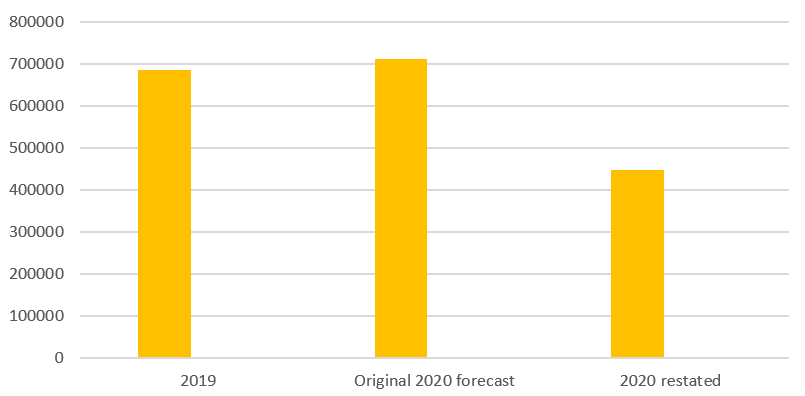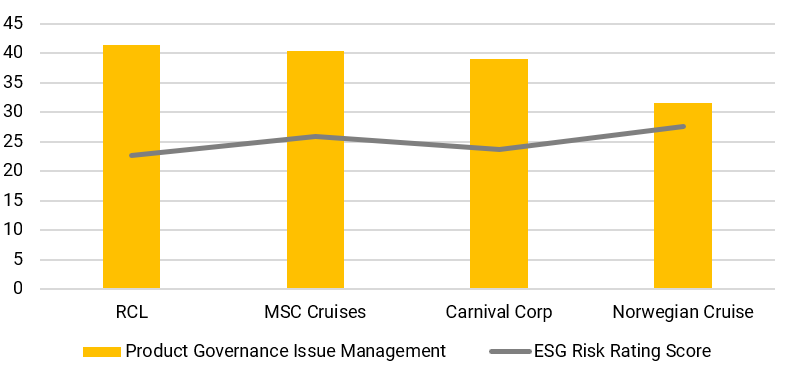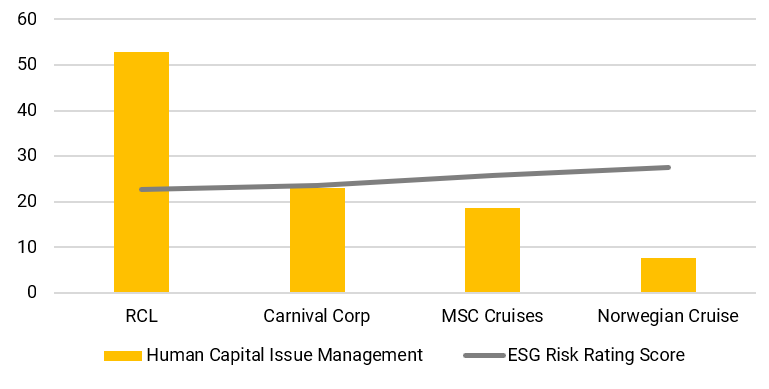In this blog, we assess the impacts of COVID-19 on the cruise ship industry by taking a closer look at the four biggest cruise companies and their COVID-19-related controversies since February 2020. We also gauge their management of product governance and human capital issues, with the aim of informing investors of each company’s preparedness to address relevant risks as well as challenges and potential hurdles in the industry’s post-pandemic operations.
All Aboard
The cruise industry has seen increased demand in recent years and has become a popular vacation choice for millions of people worldwide. The Cruise Lines International Association (CLIA)[i], an industry organization, reports that 28.5 million passengers went on a cruise in 2018 alone, accounting for an estimated USD 45.6 billion cruise industry revenue in the same year[ii]. The key players in the industry, Carnival Corp, Royal Caribbean Cruises Ltd (RCL), Norwegian Cruise Line Holdings and MSC Cruises, accounted for over half of all cruise ship passengers in 2018. Approximately 50% of 2018 passengers are from North America, followed by Europe (25%) and the Asia Pacific region (20%).
COVID-19 Pandemic: Impacts on global travel and cruise tourism
In the wake of the World Health Organization’s (WHO) declaration of the COVID-19 outbreak as a global pandemic on 11 March 2020[iii], countries around the world began restricting international travel and imposing bans on non-essential travel in an attempt to decrease the spread of the virus. These restrictions have had an unprecedented impact on the travel and tourism industry, and current forecasts estimate that the total industry revenues for 2020 will be 34.7% less than in 2019[iv] (from USD 685 billion in 2019 down to USD 447 billion estimated for 2020. The cruise industry is still suffering losses as a result and a sailing ban issued by the US Centre for Disease Control and Prevention (CDC) is expected to have further operational and financial impacts. As a result of the travel suspensions, as of April 2020, Royal Caribbean and Norwegian’s stocks have dropped more than 70% of their value within a month, while Carnival’s stock has dropped by nearly 60%[v]. With over 32% of cruise travel deployed in the Caribbean region in 2019 (see CLIA’s State of the Cruise Industry Outlook 2020) and an estimated USD 2 billion in revenues that the cruise industry contributes to the region annually[vi], the temporary halt in operations could have far-reaching financial impacts to small island nations and people who rely on cruise tourism.
COVID-19’s Impact on Global Travel and Tourism Industry Revenues from 2019 to 2020 (in million USD)

Source: Statista
Troubles at Sea
The cruise industry has not been spared from quality and safety controversies linked to the COVID-19 pandemic. In February 2020, Carnival-owned Princess Cruises announced that 3,700 passengers and crew had to be put on a 14-day mandatory quarantine after ten passengers aboard a cruise ship in Yokohama, Japan tested positive for the new COVID-19. Similar pandemic related incidents were recorded aboard Carnival-owned cruise ships, resulting in dozens of fatalities and over 1,500 confirmed COVID-19 cases in the last two months[vii]. Investigations into Carnival’s outbreak response were also launched by government agencies in Australia and the US, and liability lawsuits filed against the company over COVID-19 deaths and passenger exposure have been steadily increasing. While Carnival Corp is the only one with ongoing investigations, all major cruise companies, including Royal Caribbean, Norwegian Cruise and MSC Cruises, have also been under scrutiny for its workers’ health and safety. A report from The Guardian[viii] reveals that as of 30 April 2020, more than 100,000 cruise ship workers, with about 50 workers positive with COVID-19, are still currently trapped on the ships where they work, weeks after most passengers have been brought back to land. With international ports banning these ships from docking and with air travel on hold, crew workers are reportedly quarantined in small cabins, with limited to minimal communication with the outside world, and some of them even getting wage cuts.
Braving Stormy Waters
To understand how major cruise companies are dealing with pandemic-related quality and safety issues, it would be helpful to see how each company manages its product governance issues, as shown in the graph below:
Comparing Product Governance and ESG Risk Rating Scores

Source: Sustainalytics
Our research indicates slight differences in company performance; however, all four major cruise ship companies have average product governance issue management scores and have medium overall ESG risk scores. Despite having a more comprehensive programme on product and service safety compared to its peers, Carnival Corp’s involvement in significant quality and safety events (Costa Concordia, COVID-19 and other passenger concerns in the last few years) leads to a dilution of the company’s overall management score of its product governance risks.
On the other hand, the graph below shows how the same companies manage their human capital issues:
Comparing Human Capital and ESG Risk Rating Scores

Source: Sustainalytics
In contrast to how these companies fare on product governance issue management, Sustainalytics’ research indicates a more pronounced difference in human capital issue management performance. All four companies have the same moderate-level involvement in occupational health and safety as well as labour relations events. As shown in the graph above, RCL’s performance stands out with its comprehensive human capital policies and programmes, suggesting strong management of this issue. Carnival, Norwegian, and MSC Cruises have notable gaps in reporting relevant policies and programmes, suggesting weaker management and a slightly higher risk compared to RCL.
What Lies Ahead
With global operations at a standstill until further notice, revenue forecasts for the entire cruise industry does look rather dim, though the same could be said of other companies in the travel and tourism industry. Staying afloat until regular operations resume would be the priority for the cruise industry, and luring customers to board these ships would be the next step. Cruising is, after all, sold as a luxurious vacation experience with passenger safety guaranteed while at sea. However, the reputation of cruises has suffered immensely as images of trapped passengers and crew members in quarantined ships at the height of the COVID-19 pandemic may take a while to be forgotten. Investors may want to consider factors such as current operational impacts and reputational risks for these cruise companies in their investment decisions. Future customers and passengers would want to see stricter health and safety protocols, enhanced sanitation measures and procedures aboard the ships, as well as an emergency response plan, should similar situations arise in the future. Similarly, cruise companies that prioritize the health, safety and well-being of their crew members would be better equipped in mitigating potential human capital risks. Given the current impacts that the pandemic has on cruising, it may take some time before the industry recovers and returns to a post-COVID-19 normal.
Sources:
[i] State of the Cruise Industry Outlook 2020, https://cruising.org/-/media/research-updates/research/state-of-the-cruise-industry.pdf; accessed on 19 May 2020
[ii] Cruise Market Watch, https://cruisemarketwatch.com/market-share/; accessed on 19 May 2020
[iii] World Health Organization Europe, http://www.euro.who.int/en/health-topics/health-emergencies/coronavirus-covid-19/news/news/2020/3/who-announces-covid-19-outbreak-a-pandemic; published on 12 March 2020
[iv] Statista, https://www.statista.com/forecasts/1103426/covid-19-revenue-travel-tourism-industry-forecast; published on 22 April 2020
[v] Associated Press News, https://apnews.com/7f4a34ac407345e090c408bcbb89afda; published on 17 April 2020
[vi] Associated Press News, https://apnews.com/7f4a34ac407345e090c408bcbb89afda; published on 17 April 2020
[vii] The Guardian, https://www.theguardian.com/environment/2020/may/04/carnival-cruise-line-coronavirus-resume-operations; published on 4 May 2020
[viii] The Guardian, https://www.theguardian.com/environment/2020/apr/30/no-end-in-sight-100000-crew-on-cruise-ships-stranded-at-sea-coronavirus; published on 30 April 2020




